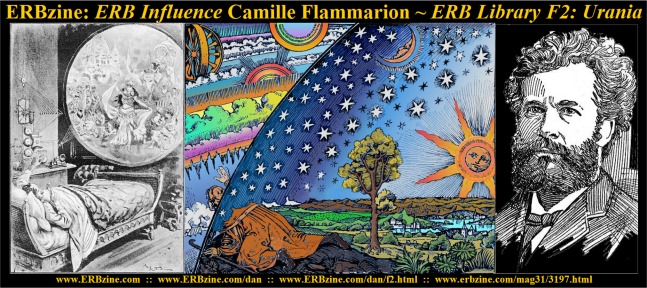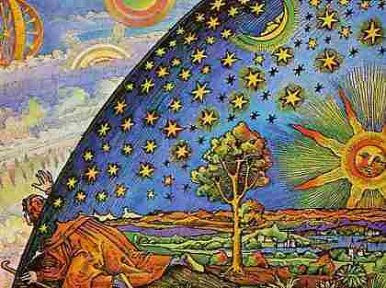
Looking For Reality
The sources of Edgar Rice Burroughs'
work are always so rich that one is at a loss as to where to begin.
This is certainly the case with Camille Flammarion. While little
known today, he had great influence in ERB's early years. He incarnated
in 1842 and disincarnated in 1925. That may be a fancy way
to say born and died but appropiate to Flammarion’s thinking. He
had very nearly established a superior reputation in his early twenties
when his writings first began to appear. Indeed, the narrator of
Urania seems to have been Flammarion himself as he is named Camille while
the narrator is already very famous in his mid- twenties. Flammarion
was a fabulous combination of the scientist and neo-Romantic. A perfect
balance to my mind and a balance that I believe Burroughs sought to emulate.
ERB acknowledged that he based his
vision of Mars on that of Flammarion. The question of when he read
his available translated works probably can't be answered, but one would
have to believe that Flammarion was fresh on his mind when he began writing
in 1911. He had also been pondering Mars for some time as the trilogy
of Under The Moons Of Mars is especially well thought out.
Apart from his desperate situation one searches for the nudge that got
him started.
The nudge may possible be found
in a Chicago Tribune article of August 9, 1908 republished here on ERBzine
by Bill Hillman. The article is entitled Are
All The Planets Inhabited? The unnamed writer is essentially
reviewing the thought of Camille Flammarion which he or she acknowledges.
Flammarion wrote a number of sci-fi volumes about Mars, many of which were
apparently translated, but which are unavailable now. There are a
great many titles available from Print On Demand publishers in French but
few in English. I have only three titles although they seem to contain
the information in the Tribune article. It’s not impossible that
ERB read only the books I have, but it seems from the description I have
of it he might also have read an 1864 title, supposedly translated, called
Real
And Imaginary Worlds.
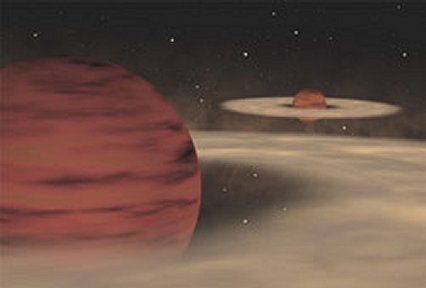
Worlds In Profusion
Over all Flammarion wrote over fifty
titles including what the English called Scientific Romances or proto-Sci-fi
as well as popular astronomy titles and volumes based on psychic research.
While he was not a member of the Society For Psychic Research he was aware
of it and was in frequent contact with Arthur Conan Doyle who was a member.
Doyle for a period of time visited him at his private observatory at his
home at Juvisy near Paris. Flammarion considered psychic research
a science. Spiritualism pervades the romances I have of him so once
again it is unquestionable that ERB was conversant in spiritualism although
he apparently rejected it.
Apart from Astronomy For Amateurs
the volumes I have are titled Lumen and Urania: A Romance.
I’ve already mentioned Lumen in my Edgar
Rice Burroughs, Camille Flammarion and Theodore Flournoy essay
here on ERBzine so I’ll concentrate on a review of Urania.
She, Urania, as one of the nine muses of Greek Mythology, was the muse
of astronomy and the head of the Muses. I have a POD facsimile reprint.
Based on that I would have to say the original was a beautiful volume.
The book was published in France in 1889, translated into English and published
in 1891. ERB would have had plenty of time to have read it.
The translation is by Augusta Rice Stetson. Between the original
and the translation it is a stunningly well written book in the Romantic
tradition. It reads as well as Charles Nodier’s Trilby, De
La Motte Fouque or E.T.A. Hoffman, all great writers from the first Romantic
period.
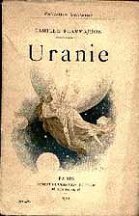 Urania
seems to have been a major influence, perhaps a catalyst on the terrific
neo-Romantic novels of George
Du Maurier which I have also reviewed on ERBzine. Du Maurier
was, of course, an ERB influence also. The tone of Urania is
also similar to William Morris’ novels who, Lin Carter believes, as do
I, was an influence on Burroughs. So a very strong romantic psychical
infuence is operating in Burroughs' imagination.
Urania
seems to have been a major influence, perhaps a catalyst on the terrific
neo-Romantic novels of George
Du Maurier which I have also reviewed on ERBzine. Du Maurier
was, of course, an ERB influence also. The tone of Urania is
also similar to William Morris’ novels who, Lin Carter believes, as do
I, was an influence on Burroughs. So a very strong romantic psychical
infuence is operating in Burroughs' imagination.
In addition to the wonderful translation
of Urania by Miss Stetson the work was illustrated by no less than
three artists with beautifully distinct styles. I think it’s worth
picking up a copy just for the illustrations, or download
the book. Really, reading the book was an ethereal experience.
The first chapter is even entitled: A Dream Of Youth.
The book is divided into three parts.
The first is an imaginary voyage through the universe, the second the love
story that sets up the third part which is a wonderful discussion of Mars
and its view of Earth. ERB toys with the this while it is very clear
where he got his ideas.
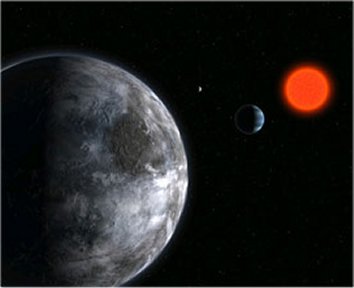
Infinite Variety

Part One
All Across The Universe

Flammarion tells a charming story
of an astronomy student who became fascinated by his professor’s clock
which has a figure of Urania on it. Urania is the muse of astronomy
in Greek Mythology. Pygmalion like this figure comes to life and
the beautiful Urania conducts Camille on a tour of the universe.
Thus the Romantic or Faerie World melds into the scientific. Very
satisfying pyschologically.
Urania is apparently capable of
traveling a few thousand times the speed of light because she take Camille
to the edge of this universe where they behold other universes across immense
stretches of empty space. Flammarion is demonstrating the concept
of infinity.
Bearing in mind that he is writing
in 1889, the concepts he is demonstrating would have been unthought by
his readers, certainly unthought by Edgar Rice Burroughs as so much of
this was adapted in his own writing virtually unaltered. John Carter's
translation to Mars can be compared to Urania's trip across the universe.
Indeed, on the way out she reaches Mars then gives a wonderful description
of how Earth would look from that planet. Flammarion’s version is
remakably close to how the Earth really does look from space as we now
know from actual pictures.
Flammarion is convinced that life
exists on all planets devising a concept of infinite variation of life
forms. This is reflected in ERB's depiction of animal and plant life
in his Valley Dor on Mars, or Barsoom in his lexicon.
Flammarion, who studied double stars
at his observatory at Juvisy has some spectacular descriptions of stellar
phenomena which, once again, are fairly accurately corroborated by the
fabulous photography of the Hubble telescope.
Now, having illustrated the concept
of infinity, on the way back Urania demonstrates the meaning of eternal.
According to Camille's ideas light emanating from a source is a continual
snapshot of that moment of that source. Thus at the speed of light
one can intercept the wave at specific times in a source’s history, in
this case, Earth. At the proper distance then one can observe, say,
the Battle of Thermopolae, Waterloo or whatever one might choose enacted
eternally, thus once created these images always exist in that light wave
and wherever the wave touches at whatever distance the scene could be perceived,
hence each moment is time is eternal.
In fact, no accurate view of the
universe is possible because the light arrives from billions of light years
distant. The light we see is so old that the stars may no longer
exist. The configuration of that place in space is now probably entirely
different from what we see. Flammarion is writing pure science fiction.
While he is seldom credited with being one of the originators of science
fiction it would appear that rather than there being a, or one father of
science fiction there are several and Flammarion is one. I think
the Scientific Romances of Hinton also qualify as well as Abbott's Flatland.
These years leading up to the twentieth century are very, very rich in
absolutely wonderful lore if you approach it in the right frame of mind.
I am no believer in parapsychology
and yet if you approach it from the point of view of these late Victorians
as possible science then the period begins to glow in irridescent colors,
flouresces before your eyes. Flammarion’s merging of romanticism
and science is just stunningly beautiful.
So, having shown his character back
to Earth Flammarion in an expert and entrancing way introduces the character
of the second section, George Spero. I’m sure that Du Maurier found
the catalyst that began his writing in Urania and Spero.
The feel, the similarities are remarkable. Du Maurier read French
so he could easily have read Urania in 1889 so the time frame is
right. His books even look like Urania.
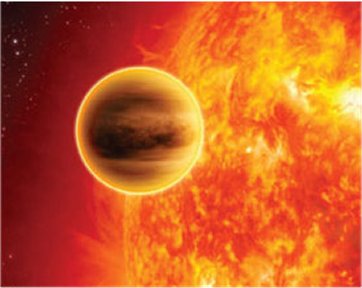
Another View Of Reality

Part II
George Spero

…to live like idiots if we do not think,
live like fools if we do.
~ Camille Flammarion
This chapter sets up the denouement
on Mars. As such it it concerns the love affair and death of Spero
and his love, Iclea. Flammarion sets the scene, time and place in
such a charming way I feel constrained to quote it. Part Second,
Chapter One:
An intense evening glow
floated in the atmosphere like a wondrous golden radience.
From the heights of Passy the view extended over the whole of the great
city, which at that time, more than ever before, was not a city, but a
world. The Universal Exhibition of 1867 had lavished all the attractions
and delights of the century on imperial Paris. The flowers of civilization
were blooming in their most brilliant tints, wasting themselves away by
the very ardour of their perfume - fading, dying in the full fervor of
youth. The crowned heads of Europe had just heard a deafening trumpet-blast
there, which was the last of the monarchy; science, arts, industry had
sown their newest creations broadcast, with an inexhaustible prodigality.
It was a general delirium of men and things. Regiments were marching,
with music at their heads; swifty-rolling vehicles crossed each other from
all directions, thousands of people were moving about, in the dust of the
avenues, quais and boulevards; but as the very dust, gilded by the rays
of the setting sun, crowned the splendid city like an aureole. The
tall buildings, towers, and steeples were ablaze with reflection from the
fiery orb; tones from a distant orchestra, mingled with a confused murmur
of other sounds - the brilliant fit ending of a dazzling summer day - poured
into the soul an undefined feeling of contentment, happiness, and satisfaction.
There was a kind of symbolical summing up about it of the evidences of
the vitality of a great people in the youth of its life and fortune.
Exhilarating what? The sense
of discovery, the feeling of perfection just around the corner, the expectation
of fulfillment when science - astronomy and psychology leading Flammarion's
way - reveals the blessed secret. The progression to perfection which
existed in Flammarion's paeon still cast a shadow in my childhood.
I was raised on it but now I look in vain for evidence of it.
With that sense of the pursuit of
the absolute, the squaring of the circle, George and Iclea prepare to step
into the brave new world of their dreams.
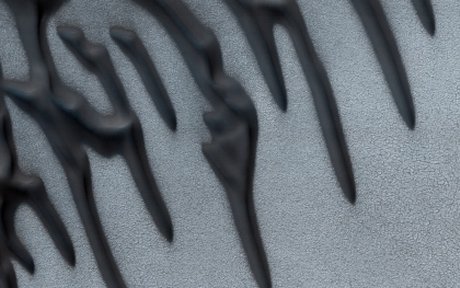
Actual Martian Landscape
The couple's meeting is one of the
loveliest I’ve read. Iclea, in Norway was standing on a hillock when
she saw her reflection in the sky greatly enlarged and in full detail.
George standing a little away but out of sight was also projected into
Iclea’s celestial image. At that time he chose to lift his hat to
the sinking sun which appeared to Iclea that he was greeting her, so she
saw his features and gestures but he didn’t see hers or her.
What was a mytery to Iclea George
could have explained as a natural phenomenon called an anthelion.
Then the next day as they were boarding a ship to leave Norway, Camille,
noticed Iclea staring fixedly at George as she recognized him as the figure
in the sky. Then moving away, he out of sight of Iclea, but she within
sight of him, he repeated his previous gesture as a salute to Norway.
Iclea once again mistook his gesture. Thus when they did meet in
Paris it was a dream come true for the girl.
The courtship is charmingly described,
as with the anthelion Flammarion faultlessly blends science with the faerie,
the romantic as a mind exalting anthem. Quite astonishing, really.
One of the central problems that Camille dealt with in the clash between
the magical and the scientific world views was the question of immortality.
The over riding fear of the scientific view was the elimination of life
after death. Man can't accept that he is materialistic, living for
the moment and completely ceasing to exist upon death, even though that
is so, thus Flammarion seeks a plausible reason for immortality.
That quest is the real reason for the 'science' of the Society For Psychic
Research, which is merely a search for the proof of life after death.
Just beautifully written though.
Thus George and Iclea have to die
tragically to prove life after death ‘scientifically.’ The couple
return to Norway where George is going to attempt to discover the height
of the aurora borealis by a balloon ascent.
Sparing the details they rise to
the height of fifteen thousand feet when the valve controlling the hydrogen
gas bursts and the balloon begins to descend. They chuck everything
overboard to slow the descent to no avail. Approaching free fall
Iclea gives George one last kiss and then sacrificing herself to love she
leaps out of the basket at several hundred feet. George bobs up to
three thousand feet then he too throws himself out a la Romeo and Juliette
to join his beloved in the great beyond. Whew!

Another Martian Landscape
We next see George’s friend and
narrator, Camille, at a hypnotic seance in the university town of Nancy.
Nancy was one of the two great hypnosis research centers in France.
Jean-Martin Charcot presided at the Salpetriere in Paris while Hippolyte
Bernstein and Auguste Liebault held court at Nancy. The seance is
within the realm of then-science, but oh so romantic. There, Camille
gains concrete evidence that life does exist after death. I transcribe
the passage, this is good:
I do not recall how, but
it happened that my conversation with him turned on the planet Mars.
After describing to me a country situated on the shores of a sea known
to astronomers under the name of Kepler’s Ocean, and a solitary island
lying in the bosom of this sea; after telling me about the picturesque
landscapes and reddish vegetation which adorned the shores, the wave-washed
cliffs, and the sandy beaches where the billows break and die away - the
subject, who was very sensitive, suddenly grew pale, and raised his hand
to his head; his eyes closed, his eyebrows contracted; he seemed desirous
of grasping some fugitive idea which obstinatley eluded him. ‘See!’
said Dr. B (ernstein?), standing before him with irresistable command;
‘see! I wish it.’
‘You have friends there,’
he said to me.
‘I am surprised at that,’
I said laughing; ‘I have done enough to deserve them.’
‘Two friends,’ he went on, ‘who
are talking about you, this very minute.’
‘Ah, ha! Persons who know
me?’
‘Yes.’
‘How is that?’
‘They have known you here.’
‘Here?’
‘Here- on the earth.’
‘How long ago was it?’
‘I do not know.’
‘Have they lived on Mars long?’
‘I do not know.’
‘Are they young?’
‘Yes; they are lovers, who adore
each other.’
Then the beloved image of my lamented
friends rose distinctly in my mind; but I had no sooner seen them than
the subject explained -
‘Yes, it is they!’
‘How do you know?’
‘I see,- they are the same souls,
same colors.’
‘What do you mean by the “same
colors”?
‘Yes, the souls are suffused with
light.’
A few instants afterwards he added,
‘And yet there is a difference.’
Then he was silent, his forehead
frowning in his effort to find out. But his face regained all its
calmness and serenity as he added-
‘He has become the woman, she is
now the man- and they love each other more than ever.’
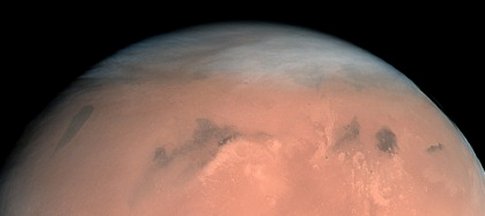
The Red Planet
Wow! There's a twist.
You really can kiss yourself. So, you see there were things going
on on Mars. Perhaps the scene is reflected in Dr. Ras Thavas, the
Mastermind Of Mars who could switch minds and bodies. As Burroughs
let his mind, his imagination play, flickering across these details that
he couldn't replicate exactly he invented variations to amaze and stun
us. Note the similarities of the balloon disaster to the balloon
flight in ERB's Pirate Blood.
The third part of Flammarion's story
Heaven And Earth deals with life on Mars. Let Urania
seize your mind, lift it and transport it instantaneously through the void
to the Red Planet.
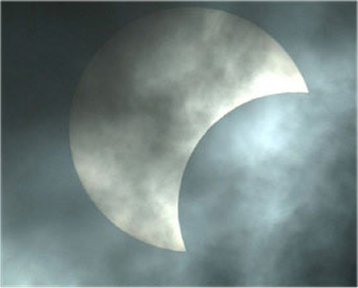
Only A World Away

Part III
Heaven And Earth

The magnetic seance
at Nancy had left a strong impression on my mind. I often thought
of my departed friend, and his investigations in the unexplored domains
of nature and life, of his sincere and original analytical researches
on the mysterious problem of immortality; but I could not think of him
now without associating him with the idea of a possible reincarnation in
the planet Mars.
~ Camille Flammarion,
Urania
If one looks at John Carter's first
translation to Mars one will remember that he disincarnated before the
Arizona cave and reincarnated on Mars, that is he left his old body behind.
It was sort of like dragging and dropping on your computer. You somehow
magically create a doppelganger of the original. Carter was
born again as a full grown man but naked came he. This is exactly
the same situation as with George Spero and Iclea. They disincarnated
on earth and reincarnated on Mars.
We wonder by what method Carter
was transported. Flammarion has possible explanations:
This idea seemed to me
to be bold, rash, purely imaginary if you like, but not absurd. The
distance from here to Mars is zero for the transmission of attraction;
[By this he means the gravitation attraction between the two planets.]
it is almost insignificant for that of light, since a few minutes are enough
for a luminous undulation to travel millions of leagues. I thought
of the telegraph, [action at a distance] the telephone, and the phonograph;
of the influence a hypnotizer’s will has on his subject many kilometers
distant; [a mistaken idea of hypnotism] and I wondered if some marvelous
advance in science might not throw a celestial bridge between our world
and others of its kind in infinity.
Alright. 'Transmission of attraction
and celestial bridges.' What kind of argument can one make against
that. Transmission of attraction is gravity and as Flammarion explains
when Mars and Earth are in alignment the two planets act on each other
disturbing their orbits in a measurable degree. I want to be in on
that next session with Dr. B. Anyway one or more of the above explanations
must have worked for Burroughs although we're sure that Carter didn't use
a celestial bridge. The distance was zero by transmission of
attraction which required only a short hop so J.C. just stepped from Jasoom
to Barsoom shedding his drawers in the process. Right on!
Camille does admit though:
…the fantastic ideas flitting through my brain prevented me from making
a truly scientific observation. A caveat, no doubt, but then, …It
is not this hypothesis which is absurd, it is the simplicity of the pedants.
Ah, ha, the bases are covered.
Now after several pages of rumination
on the possiblility of telepathy Camille is translated to Mars as in a
dream. As a prelude he says, somewhat sagely:
…astronomy and psychology
are most closely united to each other since, the psychic universe has the
material world for its habitat, while astronomy has for its subject the
study of regions of eternal life, and we could form no idea of these regions
if we did not know them astronomically. In fact, whether we know
it or not, we are living now, at this moment in heavenly regions, and all
beings, whatever they may be, are eternally citizens of heaven. It
was not without a secret divination of things that antiquity made Urania
the muse of all sciences.
While I imagine not many have read
the Book Of Urantia, a contemporary astronomical religious text,
written during Burroughs time, that text seems directly inspired by Flammarion’s
text also. Then in a hot summer ramble Flammarion rests beneath a
tree and seems to fall asleep:
I was strangely surprised
on waking up after a few minutes’ nap at no longer recognizing the landscape
or the trees, nor the river flowing at the foot of the hill, nor the undulating
meadows which stretched far away to the distant horizon. The
setting sun was smaller than we are accustomed to see it, the air thrilled
with harmonious sounds unknown to Earth, and insects as large as birds
were fluttering about the leafless trees, which were covered with gigantic
red flowers. Astonishment made me spring up with so energetic a bound
that I found myhself on my feet feeling singularly light and bouyant.
I had taken but a few steps before it seemed to me that more than half
the weight of my body had evaporated during my sleep.
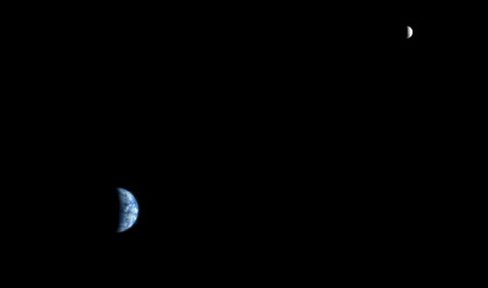
Earth From Mars
Compare that to Carter's arrival
in the Valley Dor of his second translation to Mars. As we know from
Burroughs, citizens of Mars are able to communicate telepathically.
No one on Earth does it, but is there a possibility future evolvement might
enable us to do so. On Mars Camille has a character say ‘our body
is impregnated with the solar electricity that puts all Nature in vibration.’
Electricity is indeed the stuff
of life. Let us see how life and evolution began on Earth.
Life on Earth is essentially H2O, hydrogen and oxygen. Therefor it
is evident that life began in a primordial ocean of water and certain dissolved
chemicals whose elements are known. Over millennium it is evident
these eventually combined in permutations and floated inert in the ocean
until in some way Earth’s magnetic field, electricity, activated the chemicals
making life on Earth and beginning the evolution resulting in life as we
know it.
There is little doubt that man's
brain while being only superficially different to other mammals is superior
to all beasts including apes. It is obviously superior and more highly
evolved than any hominid predecessor, although they had a certain something
that separated them from the anthropoids. So if telepathy is possible
then it must travel on electrical currents, radio waves. That means
that one mind must act as a transmitter and another as a receiver.
Presently our current is too low to allow transmission even if a mind was
tuned to our frequency as a receiver. That's the key problem for
telepathy although technically it seems possible.
Camille having been translated to
Mars and returned the next occurrence is even more startling. George
Spero returns to Earth not as a woman but as a man. This stuff
comes from an unusual mind. Remember that on Mars George and Iclea
had switiched sexes so on Mars George left a female body behind but he
appears here on Earth in his male form. So you can sort that out
as you will with the following:
Shortly after the accident
on Lake Tyrinfiorden he had felt like a man who awakes from a long and
heavy sleep…. He was alone in midnight darkness on the border of a lake;
he knew that he was living, but could neither see nor feel himself.
The air did not affect him; he was not only light but imponderable.
Apparently what remained of him was solely a thinking faculty. His
first idea on trying to remember was that he had awakened from the fall
by the Norwegian lake; but when day broke he saw he was in another world.
The two moons revolving rapidly in the sky in opposite directions made
him surmise that he was upon our neighbor, Mars. He lived there
for a while
in the spirit state, and recognized there the presence of a
very beautiful humanity, in which the feminine sex reigns supreme, from
an acknowledged superiority over the masculine sex. These organisms
are light and delicate, their density of body very slight, their weight
slighter still. On the surface of this world natural force plays
a secondary part in nature; delicacy of sensation checks everything.
There is a large number of animal species, and several human races.
In these species and races the feminine sex is stronger and handsomer (the
strength consisting in the superiority of sensation; than the masculine
sex, and it is she who rules the world.

Sunset On Mars
Flammarion was obviously a feminist.
His great desire to know
the life before him induced him not to remain long as an unlooker in the
spirit state, but to come to life again under a corporeal form, and knowing
the organic condition of the planet, in a feminine form.
Right. Be on the dominant side.
Iclea apparently wishing to remain dependent to George chose the male sex.
The two then unite into one being. It's not clear what the status
of a unisex was on Mars. Naturally Martians are much more advanced
than Earthlings as are all extra-terrestrials in our imaginations.
Of course they have to know more than we to get from where they were to
where we are as the reverse is impossible for us. Like all extraterrestrials
Martians know a lot.
They have invented , among
other things, a kind of telegraphic apparatus, in which a roll of stuff
[film?] constantly receives a picture of our world, and it is impressed
by it, unalterably, as it unrolls. An immense museum devoted expressly
to the planets of the solar system, preserves all these phtographic pictures,
fixed forever in chronolgical order.
George Du Maurier calls these little
bags of memory which he is fearful of losing on death. There's a
collecting mania that beats Andy Warhol all to pieces. George reveals
that it was he on Mars who spoke to Camille in the form of a beautiful
maiden extending his arms to George. Wow! There's some implications
there. As sci-fi this is very advanced.
‘But then,’ I cried, ‘if
you are that Martial maiden, how can you appear to me in Spero’s form,
when he no longer exists?’
‘I do not act upon your retina or
your optic nerve,’ he replied, ‘but on your mental being and your brain.
I am in communication with you now; I influence directly the cerebral seat
of your sensations.’
I think I bought that bridge once,
but excellent sales job here, certainly the reverse of what you see is
what you get.
'It is the same, too in
conditions of hypnotic somnambulism. You see me and hear me, you
feel me, too, by your brain, which is under influence; but I am no more
in the form, which you see than the rainbow exists in the presence of the
eyes that look at it.'
Isn’t that good? Flammarion is
a genius even though he is a little off track, not his fault not that much
was known then, especially the nature of hypnotism and its actions on the
mind. Then here's the clincher that proves ERB read and was influenced
by this book:
‘I must confess,’ I answered,
‘that I cannot understand your Martial beings as having six limbs.’
And then when Flammarion looked away
and looked back the apparition had disappeared. The watchman returned
and the Martian story ends.
Thus begins the final chapter of
the story The Fixed Point In The Universe in which Flammarion tries
to tie up the Faerie and Science aspects of his story -- the entwining
of the Romantic and the Scientific. While it isn't quite as
noticeable in Burroughs, at least in the first burst of stories from 1911
to 1914, that is exactly what Burroughs tries to do, enclose the Faerie
within the scientific. Ray Bradbury would try the same thing in his
The Illustrated Man and The Martian Chronicles.

Martian Horizon
Flammarion establishes the scientific
aspect in a magnificent summation of man's progress toward understanding
the place of the Earth in the universe. I quote it because it is
a superb understanding that I don't believe is universally understood:
The Earth is not what it
seems to be. Nature is not what we think….
The natural and direct impression
given by the observation of Nature is that we inhabit a solid, stable Earth,
fixed in the centre of the universe. It took long centuries of study
and a great deal of boldness to free ourselves from that natural conviction,
and to realize that the world we are on is isolated in space, without any
support whatever, in rapid motion on itself and around the Sun. But
to the ages before scientific analysis, to primitive peoples, and even
today to three quarters of the human race, our feet are resting on a solid
Earth which is fixed at the base of the universe, and whose foundations
are supposed to extend into the depths of the infinite.
And yet from the time when it was
first realized that it is the Sun which rises and sets every day; that
it is the same Moon, the same stars, the same constellations which revolve
about us, those very facts forced one to admit with absolute certainty
that there must be empty space underneath the Earth, to let the stars of
the firmament pass from their setting to their rising. This first
recognition was a turning-point. The admission of the Earth’s isolation
in space was astronomy’s first triumph. It was the first step, and
indeed the most difficult one. Think of it! To give up the
foundations of the Earth! Such an idea would never have sprung from
any brain without the study of the stars, or indeed without the transparency
of the atmosphere. Under a perpetually cloudy sky, human thoughts
would have remained fixed on terrestrial ground like the oyster to the
rock.
The Earth once isolated in space,
the first step was taken. Before this revelation, whose philosophical
bearing equals its scientific value, all manner of shapes had been imagined
for our sublunary dwelling place. In the first place, the Earth was
thought to be an island emerging from a boundless ocean, the island having
infinite roots. Then the Earth, with its seas, was supposed to be
a flat, circular disc, all around on which rested the vault of the firmament.
Later, cubic, cylindrical, polyhedric forms, etc., were imagine.
But still the progress of navigation tended to reveal its spherical nature,
and when its isolation, with its incontestable proofs, was recognized,
this sphericity was admitted as a natural corollary of that isolation and
of the circular motion of the celestial spheres around the supposed central
globe.
The terrestrial globe being from
that time recognized as isolated, to move it was no longer difficult.
Formerly, when the sky was looked upon as a dome crowning the massive and
unlimited Earth, the very idea of supposing it to be in motion would have
been not only absurd but untenable. But from the time we could see
it in our minds, placed like a globe in the centre of celestial motion,
the idea of imagining that perhaps this globe could revolve on itself,
so as to avoid obliging the whole sky and the immense universe to perform
this daily task, might come naturally into a thinker’s mind; and
indeed we see the hypothesis of the daily rotation of the terrestrial sphere
coming to light in ancient civilizations, among the Greeks, the Egyptians,
the Indians, etc. It is sufficient to read a few chapters of Ptolemy,
Plutarch, or Surya-Siddhanta for an account of these conjectures.
But this new hypothesis, although it had been prepared for by the first
one, was none the less bold, and contrary to the feelings inspired by the
direct contemplation of Nature. Thoughtful mankind was obliged to
wait until the sixteenth century, or, to speak more correctly, until the
seventeenth century, to learn our planet’s true position in the universe,
and to know by supported proofs that it has a double movement- daily about
itself, and yearly about the Sun. From that time only, from the time
of Copernicus, Galileo, Kepler and Newton, has real astronomy existed.
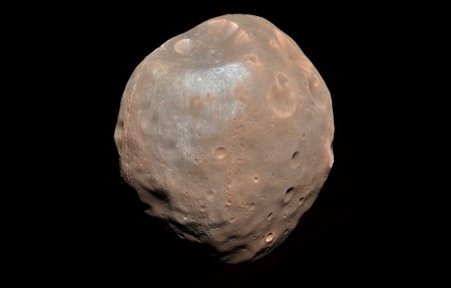
One Of The Moons Of Mars
A brilliant and remarkable synthesis
of astronomical knowledge. Burroughs frequently mentions his debt
to Flammarion while I have yet to see where he refers to Percival Lowell.
Lowell, himself visited Flammarion at Juvisy where he, it would seem, learned
from the master.
We have seen that in 1908 The Chicago
Tribune recapitulated Flammarion’s vision of Mars and not Lowell's on its
pages with illustrations. Burroughs said that he based his vision
of Mars on Flammarion and adapted to more correct knowledge when it appeared.
It seems clear that Burroughs was
fully exposed to the paranormal/Theosophical viewpoints borrowing only
what he found useful while rejecting the rest while very like believing
none of it. Like Flammarion he accords telepathic powers to Martians
but they are not effective with the Earthman, John Carter.
As the magical world of the fairies
of the first Romantic period had metamorphosed into the pseudo-scientific
paranormal Flammarion too has metamorphosed his magical longings into a
scientific framework while accepting modern scientific astronomy.
However he still confuses the two because of the longing for personality
immortality. He accords full scientific values to the Society For
Psychic Research because they seem to follow rigorous scientific methods
yet the unconfirmed anecdotes they rely on he accepts as attested facts
while they aren't. It’s odd that with his trained mind he couldn't
see the fallacy.
And then while being a very able
astronomer he merely decides that all the planets in the universe are inhabitable
and then populates them. Thus he believes that Mars as a fact is
fully peopled with flora and fauna like Earth's but more exotic and spiritual.
He imagines a nearly infinite variety
of life, that is human-like intelligent life when in fact to this date
all planets but Earth are barren of life. Venus isn't even watery.
What a blow that truth was.
Burroughs combined this wonderful
fantastic fairyland displaced from Earth with evolution to imagine a fantastic
array of life forms both on Earth and other planets, even beyond the farthest
star.’
Both men were neo-Romantics although
Flammarion having been born earlier was more heavily influenced by the
first Romantic period while the much younger Burroughs was more acclimated
to the scientific. By the time he began to write autos, planes, telephones
and electricity had already transformed the world while radio and television
were just round the corner. Talk about action at a distance
and telepathy. God, Skype.
It was a wonderful time when all
things were possible if improbable. Truly, astronomy and psychology
would be the cornerstones of the Brave New World that awaits. Will
it be Utopian or Dystopian?

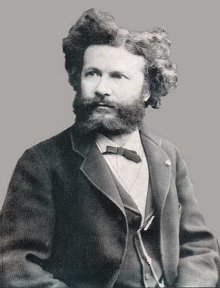
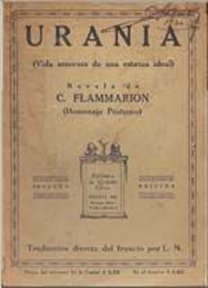

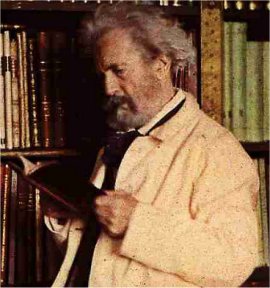


 Urania
seems to have been a major influence, perhaps a catalyst on the terrific
neo-Romantic novels of
Urania
seems to have been a major influence, perhaps a catalyst on the terrific
neo-Romantic novels of 









